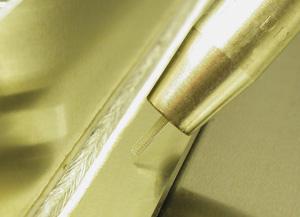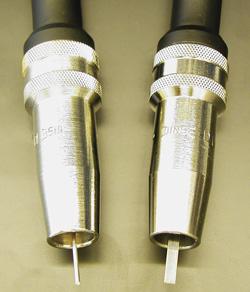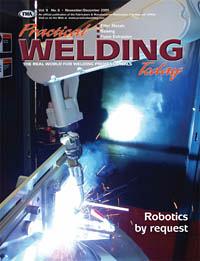- FMA
- The Fabricator
- FABTECH
- Canadian Metalworking
Categories
- Additive Manufacturing
- Aluminum Welding
- Arc Welding
- Assembly and Joining
- Automation and Robotics
- Bending and Forming
- Consumables
- Cutting and Weld Prep
- Electric Vehicles
- En Español
- Finishing
- Hydroforming
- Laser Cutting
- Laser Welding
- Machining
- Manufacturing Software
- Materials Handling
- Metals/Materials
- Oxyfuel Cutting
- Plasma Cutting
- Power Tools
- Punching and Other Holemaking
- Roll Forming
- Safety
- Sawing
- Shearing
- Shop Management
- Testing and Measuring
- Tube and Pipe Fabrication
- Tube and Pipe Production
- Waterjet Cutting
Industry Directory
Webcasts
Podcasts
FAB 40
Advertise
Subscribe
Account Login
Search
Using flat wire in GMAW
A new twist on a traditional process
- By Dirk Dzelnitzki
- November 8, 2005
- Article
- Consumables
 |
| These shielding gas nozzles are standard for flat-wire applications. |
Companies that manufacture products requiring intensive welding are being forced to optimize their production processes and produce more efficient welding methods to remain competitive. They must use new technologies and increase the economic viability of existing production methods.
The use of conventional gas metal arc welding (GMAW) has grown over the last few decades—it's now utilized in more than two-thirds of all welding tasks. GMAW's flexibility, handling, and suitability for manual and automatic applications have made this a suitable process for joining metals. Although GMAW has been optimized over this time period, it still has possibilities for improvement. Using a flat-wire electrode is one way to increase GMAW capabilities.
Flat-wire GMAW (using a wire that has a rectangular cross section) incorporates the positive properties of GMAW with the capabilities of two round-wire electrodes (seeFigure 1). Depending on the application, the flat wire's welding rate and filling volume performance approach that of two-wire technology without having to maintain two independent wire delivery systems.
Flat-wire Operating Principle
GMAW with a flat wire basically takes place under the same process conditions as those applicable to round wire. Spray and pulse electric arcs are used with flat wire as well.
A typical flat wire is 4 millimeters by 0.5 mm. This is roughly the same cross-sectional area of a 1.6-mm-diameter round wire. What makes flat wire different is the circumferential area. The flat wire is 9 mm in circumference, while the 1.6-mm-dia. round wire is 5 mm. This gives the flat wire approximately 45 percent more surface area.
 |
| Figure 1 The round wire (left) is 1.6 mm in diameter, while the flat wire is 4 mm by 0.5 mm. |
Current is best conducted around the outside of the welding wire because of what is known as the skin effect.1,2Skin effect is the result of induced voltage created by changing magnetic fields and other parameters that produce resistance to current flow in the center of a welding wire that aren't present around the perimeter. With increased surface area, more current can be transferred with less resistance, which can help increase welding speeds through the change in the wire's shape.
In flat-wire GMAW, an electric arc covers the entire width and fuses fully along this width. This creates an asymmetric electric arc on the flat wire.3Depending on how the flat wire is oriented to the weld, it may produce a wide, shallow weld pool, which is suitable for bridging gaps or for a narrow, deeper weld pool for deep penetration and increased weld speed.4To achieve a wide, shallow pool, the flat wire is oriented perpendicularly to the weld seam. A narrow, deep weld pool is generated when the flat wire is oriented parallel to the weld seam. Variations of the flat-wire angle to the weld seam can produce different weld pools for applications in which a combination of weld properties is necessary.
Typical sheet metal production tolerances result in gaps between the mating parts. Perpendicular flat-wire welding can achieve continuous welding without the need to weld with a weave pattern or reduce speed to bridge the gap for an acceptable weld. For thick-material applications, parallel flat-wire welding can increase speed and penetration depth. Other welding processes also can benefit from varying the angle between the perpendicular and parallel positions.
Welding Equipment
Power sources with a welding current of at least 400 amps are recommended for flat-wire GMAW of steel. GMAW aluminum applications can be implemented using welding currents of about 500 amps. The wire feeder and the welding torch are especially critical.
Automatic welding requires a complete wire feed system that transports the flat wire powerfully and consistently over long distances. A high starting torque and high drawing capacity offer reproducible wire feed rates for consistent and continuous operation.
The system needs to be compact: The wire feed motor is coupled directly with the welding torch. The same shield gas nozzles used with round wires also are used with flat wires (see lead photo).
The high thermal stresses that arise during flat-wire GMAW require a welding torch equipped with a twin-circuit cooling system that permits separate liquid cooling of the shaped contact tip and shield gas nozzle. Secure power contact is achieved through a specially designed and shaped contact tip.
Filler Materials and Shielding Gases
Flat wire is available in all common qualities. It usually is produced from round wire with an additional rolling process. This technique rounds off sharp edges to help increase the profiled contact tip's and wire guide hoses' service life. The same shielding gases used with round wires are used with flat wires.
Practical Applications and Perspectives
Typical flat-wire applications include welding construction machines, structural steel, containers, and vehicles. This technique is used for continuous, automatic welding of semifinished products such as pipes, profiles, and strips, as well as for manufacturing parts like axles, body components, and rims. The automotive industry uses this technique to join difficult-to-weld aluminum components.
GMAW with flat-wire electrodes currently is used in shipbuilding for plate-stringer joints. Panels are welded for complete sections of ships. Fillet seam welding of common ship profiles usually are welded on both sides at the same time to keep shrinkage and the component's natural stress characteristics as low as possible.5
Dirk Dzelnitzki is technical director for Dinse GmbH, Tarpen 36, D-22419 Hamburg, Germany, dzelnitzki@dinse-gmbh.com, www.dinse-gmbh.com. Dinse is represented in the U.S. by MPT Inc., 1080 Classic Road, Apex, NC 27539, info@mpt-inc.com.
Notes
1. A. Schneider and H. Zimmer, Physik fr Ingenieure, Band 1: Mechanik, Wrme, Elektrizitt und Magnetismus VEB Fachbuchverlag, Leipzig, 1987, p. 457.
2. K. Lunze, Einfhrung in die Elektrotechnik, VEB Verlag Technik, Berlin, 1988, p. 260.
3. U. Dilthey, K. Willms, H. Heuser, and G. Sandner, "MSG-Schweien und MSG-Lten von Unlegierten Sthlen mit Bandelektroden," Schweien und Schneiden 2004, DVS-Berichte Band 232, Verlag fr Schweien und Verwandte Verfahren DVS-Verlag GmbH, Dsseldorf, 2004, pp. 111-116.
4. Ibid.
5. Ibid.
About the Author
About the Publication
subscribe now

The Welder, formerly known as Practical Welding Today, is a showcase of the real people who make the products we use and work with every day. This magazine has served the welding community in North America well for more than 20 years.
start your free subscription- Stay connected from anywhere

Easily access valuable industry resources now with full access to the digital edition of The Fabricator.

Easily access valuable industry resources now with full access to the digital edition of The Welder.

Easily access valuable industry resources now with full access to the digital edition of The Tube and Pipe Journal.
- Podcasting
- Podcast:
- The Fabricator Podcast
- Published:
- 04/16/2024
- Running Time:
- 63:29
In this episode of The Fabricator Podcast, Caleb Chamberlain, co-founder and CEO of OSH Cut, discusses his company’s...
- Industry Events
16th Annual Safety Conference
- April 30 - May 1, 2024
- Elgin,
Pipe and Tube Conference
- May 21 - 22, 2024
- Omaha, NE
World-Class Roll Forming Workshop
- June 5 - 6, 2024
- Louisville, KY
Advanced Laser Application Workshop
- June 25 - 27, 2024
- Novi, MI































